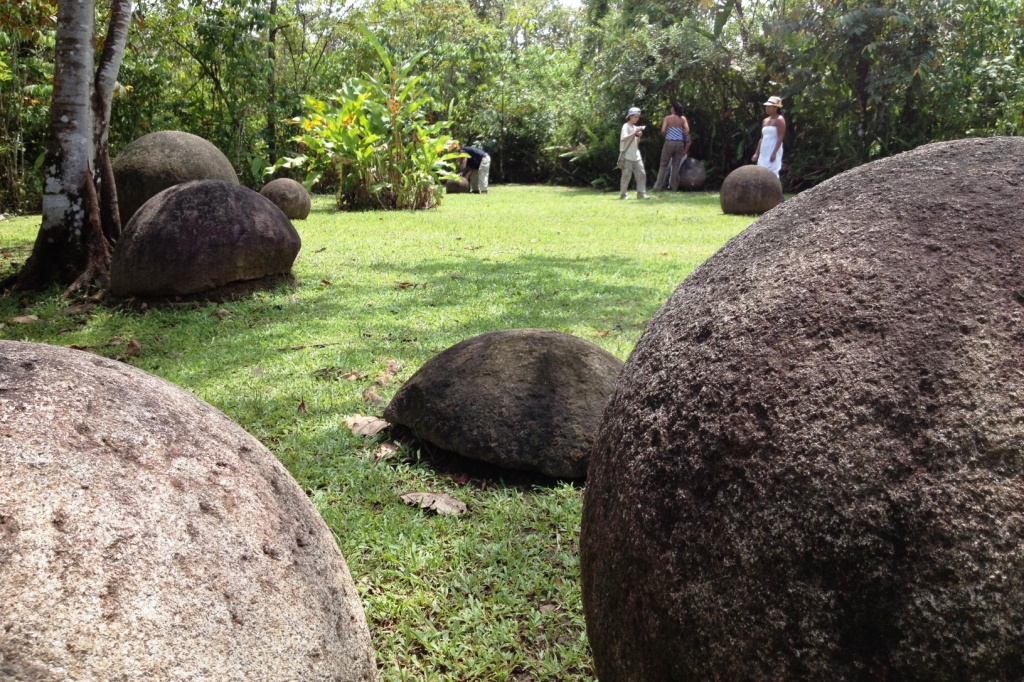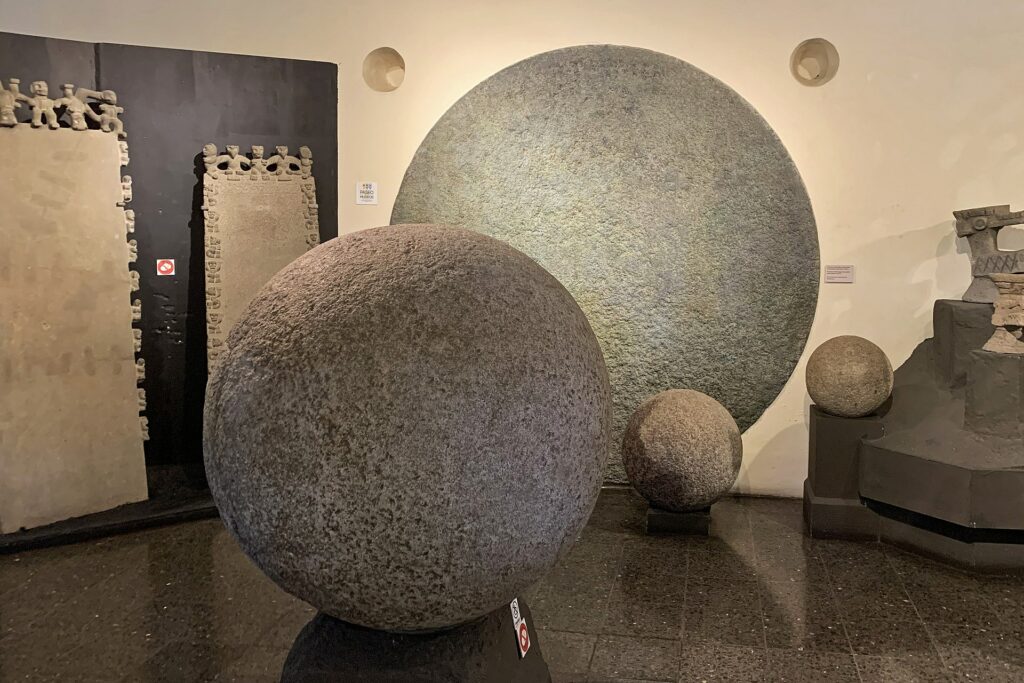Last updated on March 8th, 2023 at 05:35 am
In the opening scene of Indiana Jones and the Raiders of the Lost Ark, we see Harrison Ford running from a giant stone sphere. It seems just as much fantasy as the rest of the movie except for one thing: The Hollywood sphere that he was running from was inspired by actual pre-historic orbs that were discovered in southern Costa Rica in the late 1930s.
These hundreds of stone spheres, separated into four distinct settlements along the Diquís Delta of Costa Rica, have caused no shortage of wonder over the decades.
From theories that they came from an alien race to others that say they’re relics of the lost city of Atlantis, these oddly smooth and polished – not to mention enormous – balls of stone are a phenomenon that has yet to be fully explained.
Fortunately, archeology has provided clues that can shed light on who created these mysterious objects and how these pre-historic craftsmen might have lived.

Discovery of the Stone Spheres
As amazing as these giant stone spheres may seem now, when United Fruit Company workers first discovered them in 1939, there was far less curiosity.
In fact, they were seen as a nuisance. The workers who found the spheres were clearing the jungle for the expansion of the company’s plantations, which were being threatened by disease all along the country’s Atlantic coast.
Facing not only disease but labor unrest as well, United Fruit had very little interest in a bunch of strange-looking stones.
The company went about moving them. The smaller ones were pushed out of the way by hand, while the larger ones – some weighing up to 16 tons – were removed using bulldozers.
Once out of the way, the workers could continue their task of cutting down the jungle. But the stones weren’t completely forgotten.
A rumor soon spread that these mysterious stones held rich deposits of gold. Gold-seekers arrived and quickly got to work drilling holes in the stones, then blowing them up with dynamite.
It didn’t take long for a significant portion of the pre-historic craftsmanship to be ruined.

Investigating the Mysterious Stones
Fortunately, it wasn’t only gold-seekers who were interested in the stones.
As it turned out, the daughter of the United Fruit Company’s president – whose name happened to be Doris Stone – was an ethnographer and archeologist who studied pre-Columbian artifacts in the very region where the discovery had been made.
She was the first to conduct a detailed study of the spheres, but other scientists soon followed her.
Samuel K. Lothrop, a well-known archeologist who had already spent years working in other Latin American countries, arrived in 1948, originally planning to visit an area in the country’s northwest region.
His plans changed after meeting Doris Stone, who suggested he go to the Diquís Delta instead. A civil war had just broken out in Costa Rica, and she assured him that he would be safer in the south, closer to the banana plantations.
Stone, Lothrop, and scores of other archeologists over the decades have analyzed the stones and theorized about the culture and politics of the people who made them.
There is a lot about the stones that still remain a mystery, but the work that’s been done has helped shed light on how these ancient stone builders may have lived.
Who Made the Stone Spheres of Costa Rica?
The people who crafted the mysterious stones of the Diquís Delta are no longer around, and with no written record of their culture, we have to rely on archeology to provide us with clues as to what their lives were like.
Currently, scientists believe that the stones began to be crafted around 600 AD and continued being made up until some point before the Spanish arrived at the end of the 15th century.
This coincides with what is known as the Chiriquí period. Archaeologists believe that the societies living in southern Costa Rica during this period were agricultural, hierarchical, and had distinct religious beliefs.
Some of the material evidence that’s been discovered around the stone spheres of the Diquís Delta include landfills, cemeteries, and walls made up of round stones.
Based on these settlements’ composition and layout, researchers have sketched out a rough idea of how hierarchy operated within these societies.
For example, simple and elaborate burial sites show that status likely varied within the communities.
Public works requiring large amounts of labor, such as the stone spheres, generally indicate that someone would have been tasked with overseeing the workers.
All of this points to a stratified society where some people wielded power and influence over others.
Unfortunately, we still don’t know why the people of the Diquís Delta made these giant stone orbs. But considering the tools and resources available to them at the time, it would have been an extraordinary undertaking.
But just how difficult was it?
How to Create a Perfectly Round Stone
For one thing, many scientists agree that the quarry from which the stones originated would have been located at least 20 kilometers from the settlements of the Diquís Delta, which means the people who created the stone spheres would have first had to find a way to transport the heavy raw material.
Once they had secured a piece of rock, they would carve it using chisels and wedges, which would have been made out of the same material as the stone itself, a hard, volcanic rock similar to basalt.
They would have also used a process of intermittent heating and cooling to help speed up the removal of layers of stone.
According to some archeologists, including Doris Stone, they also relied on wooden frames to measure out the exact size and shape of the rock that would have to be chiseled away.
The end result of this laborious process is the hundreds of giant stone balls that, after centuries, continue to decorate the landscape of southern Costa Rica.
While some were shipped off to private collections and universities decades ago, hundreds still remain. And as long as mysterious stones dot the Diquís Delta’s landscape, these creations’ murky origins will continue to raise questions and inspire new answers.
Those answers may one day help us learn more about a vanished civilization whose works we still marvel at today.
If you enjoyed this post, read more about the mysterious Schist Disk.
Sources
Objects of Wonder: Costa Rica’s Stone Spheres – JSTOR DAILY. https://daily.jstor.org/objects-wonder-costa-ricas-stone-spheres/.
Centre, UNESCO World Heritage. “Precolumbian Chiefdom Settlements with Stone Spheres of the Diquís.” UNESCO World Heritage Centre, https://whc.unesco.org/en/list/1453/.
Corrales, F. y A. Badilla. 2018. Sociedades jerárquicas tardías en el delta del Diquís, sureste de Costa Rica. Cuadernos de Antropología 28(2):1-22. ISSN: 2215-356X.
“Las Extravagantes Teorías Sobre El Origen De Las Misteriosas Esferas De Costa Rica.” BBC News Mundo, BBC, https://www.bbc.com/mundo/noticias/2014/07/140701_cultura_teorias_esferas_piedra_unesco_costa_rica_lv#:~:text=La%20existencia%20de%20las%20esferas,texto%20cient%C3%ADfico%20es%20de%201943.
Thiemer-Sachse, Ursula. UN Asunto Redondo: Reflexiones Sobre Las Sociedades autóctonas En La región Del diquís / Costa Rica y panamá, Durante Los Últimos Siglos Antes De La Conquista española y La Importancia De Las Famosas Bolas De Piedra. Iberoamericana, 2005.
X, Science. “Researchers Investigate Mysterious Stone Spheres in Costa Rica.” Phys.org, Phys.org, 22 Mar. 2010,
https://phys.org/news/2010-03-mysterious-stone-spheres-costa-rica.html

